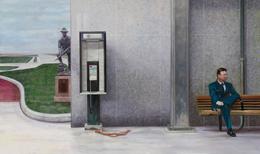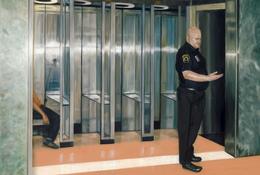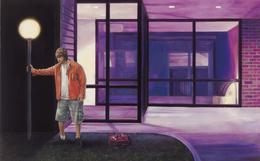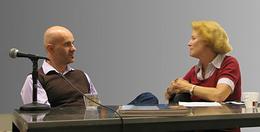Detour as a Route to Unity and Order
In this essay the New York based art-critic Carol Strickland stamped the term of the Sottorealismus in relation to Leipzig School painter Aris Kalaizis for the first time. In addition, some interesting interpretations to the american paintings are in it

“’Tis the good reader that makes the good book,” according to the American writer Ralph Waldo Emerson. The same is true of good paintings. The more complex and multi-layered the painting – resistant to a quick, easy reading – the more it requires a vigilant responder. After contemplation and reflection, the painting blossoms in the mind. This evocative quality makes encountering of Leipzig based painter Aris Kalaizis’ so exciting.
It’s no wonder each painting opens up new worlds to the careful observer, for Kalaizis constructs his composition using multiple modalities. Like a set designer, he chooses each object judiciously. Then he arranges them in the pictorial space, so the objects, figures, and space between them vibrate with intensity. Like a screenwriter, he constructs a tableau fraught with drama and internal conflict, infusing the scene with tension. With the eye of a perfectionist director, he calibrates all elements for maximum visual impact. And, of course, like a consummate painter, he wrings the most effect out of color, line, shapes, and form. He creates unity and order from pigment and structure, but always with the incipient threat that this equilibrium is about to fall apart.
Kalaizis’ method begins with an inner vision – an initially somewhat vague idea which he later attempts to explore during the course of his work. He searches for an actual scene, like a stage on which he can set his fantasy, then he photographs this backdrop. Acting as a filter between reality and his own invention, he purifies the background, eliminating unnecessary detail and emphasizing elements of the “script” which are to characterize the newly created painting. In the process, he discovers surprises, which affect the scene as it evolves.
…form, color, and structure as a seedbed
His goal during this lengthy process is not to imitate the appearance of surface reality but to use form, color, and structure as a seedbed from which his abstract concept can grow. If a painting veers towards explicit representation, he makes it more elusive, preferring to re-shape his intentions. The reality he represents is never reality as it actually exists but a new, constructed reality. “I’m not interested in seeing what is,” Kalaizis says. “I’m more interested in what could be.”
As Kalaizis gradually imagines a story in his mind, it often requires figures to act out the narrative. He then photographs people, whom he’ll translate into characters in his scenario.
He captures a slice of life by freezing a moment latent with significance into stasis. But the surface calm belies the upheaval beneath. It’s like an innocent fin cutting through an azure, tropical sea, concealing a killer shark as it circles its prey.
The effect of studying a painting by Kalaizis is like adding a third dimension to a two-dimensional picture. The viewer is ripped out of passive observation into active participation. It takes an alert viewer to evoke and possibly complete this implied narrative interpretation.
The painting Keyville (2006) illustrates the power of his art to engage the viewer. The scene has the unsettling quality of a piazza by de Chirico, teeming with unsettling allusions, a sense of menace, and enigmatic associations. Here an enigma is the literal fulcrum of the painting, for an orange scarf lies abandoned front and center. Above it dangles a telephone off the hook, as if the wearer of the scarf exited with great haste. Was she too distressed by news she received on the telephone to hang up? Was she called away by emergency? Was she abducted?
…the reality he represents is never reality as it actually exists but a new, constructed reality
Bracketing either side of the central void are a statue of a soldier holding a rifle, poised as if for action, and a seated man, oblivious to any danger. Warm color links what seem to be three separate sequences (divided by vertical bars). The reddish curve on the left side leads to the rose-colored plinth on which the statue stands to the inverted curve of the orange scarf, pointing towards the same hue of the wooden bench on which the man sits, as immobile as a statue.
Both content and structure pose elusive questions: is the missing woman a victim of violence, which both the stone soldier and the unresponsive man were powerless to prevent? The viewer ponders: what events preceded and follow this scene? A calculated incompleteness is the reigning strategy, which sucks you into the painter’s world, plunging you into uncertainty.
On Gertrude Stein’s deathbed, the writer posed the question, “What is the answer?” Her reply: “What is the question?” For Kalaizis, too, questions are more important than answers.
Even Kalaizis’ landscapes have an abstract, puzzling composition that invites interpretation. The Olentangy River II (2005) seems a peaceful autumnal scene, the distant trees and their reflection rendered with virtuosic skill. Then you notice the concrete points of a boat ramp, poised like sharp daggers above the water, undercutting all serenity. The strange, rudder-shaped concrete mass floating in the foreground also injects a note of contradiction, setting up a dialectic between the natural and the manmade world. The first response is a sigh. The second is a shudder.

Kalaizis is a painter of polarities. He pokes and prods, awakening your imagination to respond to his. In Broad Street No. 100 (2005), another telephone receiver dangles, this one in a phone booth in which a body slumps, its head out of sight. Is the young man sleeping, drugged, or dead? Beside the occupied stall, three empty, sterile booths extend. A uniformed policeman, his face a sinister mask, looms in the foreground, posed like a stalwart pillar of authority. But upsetting the taut equation of cell-like vertical forms is the image of the policeman staring at his hand in distaste like Lady Macbeth, examining his fingers. You’re compelled to ask, “What’s going on?”
… a painter of polarities
Rubbacord (2005) goes even further into a realm of irrationality. Turbulent clouds form a vortex above a set of stairs that seem to go nowhere, while a purple sea laps at its base like a rising tide. Set into a concrete wall is an orange rectangle displaying a sensual, nude body of a woman. Her head is cut off, reflected upside down on the wet pavement. The painting contrasts hard and soft surfaces, straight lines and curves, animate and inanimate forms, mobile and stable masses. Reflections and shadows in this stormy scene appear nonsensical. The painting is devoid of humanity but bristling with mystery.
Kalaizis’ bravura handling of paint deserves mention. He’s a maestro of concrete. In most hands, concrete is a mute, matte – even brutal – surface. When Kalaizis paints it, his brushstrokes delicately streak the walls with soft, pastel zips, subtle as a Morris Louis stain painting.
One clue to the painter’s latent meanings resides in recurring imagery. Like Alfred Hitchcock making his signature, cameo appearance in each film, this personal iconography pops up again and again. A favorite motif is the figure of a woman with an orange headscarf, dressed in black, carrying a black purse. The figure, based on Kalaizis’ wife Annett, appears in The Ohio Hotel (2006), her back to the viewer, her gaze averted, and her purse held in a vulnerable position. Opposite her, facing the viewer, stands a feral-looking man brandishing a baseball bat. Kalaizis bisects the space between the two figures (protagonist and antagonist?) with a threatening shadow, cast by a huge tree on a luridly colored building. The man stands behind a wave-like shape of black that looks like furry asphalt, while the woman walks on a field resembling a purple sea. Nothing quite makes sense, but you feel the woman is in danger. The viewer is impelled to fill in the blanks.

An Afternoon in Upper Arlington (2005) is similarly disquieting. The title indicates daytime. Yet the purple light and darkness, illuminated by a bright lamp clutched by a thuggish-looking man, paradoxically suggest a night scene. An open briefcase – as if its contents have been plundered – lies on the ground next to the man, whose eyes are concealed. Mystery shrouds the scene, yet the bright ball of light seems a beacon of clarity. Its post is literally a staff on which the man leans for support.
The painting recalls Kalaizis’ 2004 painting, Die Lichtung (2004), translated as The Enlightenment. The painter’s daughter stares into a Donald-Judd like arrangement of light cubes, as if searching for the answer to life’s mysteries. Die Lichtung can also be translated as a clearing in a forest, which suggests the charged central space in many of Kalaizis’ works. It’s like an open-ended vanishing point, a clearing where the subterranean meanings might dwell in a burst of light.
Kalaizis’ mystifying paintings share similarities with the surrealism of Magritte, as when he paints semi-realistic pictorial space but populates it with illogical, disturbing content. The House (2005) is almost a tour-de-force of realism, with beautifully rendered trees and a masterful, full-length portrait of a man, in revery, leaning against a beech. Then Kalaizis twists this tranquil scene in another direction, first with his graffiti scrawl of a flower on the wall of a small house, then with a nude woman’s body spotlit in a murky, blue window, as if she’s a siren submerged in an aquarium. Longing and loneliness suffuse the scene.
…“To make a detour is one of the main qualities in my work.”
Just when a painting seems “calm and friendly,” Kalaizis says, “I like to open the closet with the poison pills.” And just when you think you’ve got his drift, he zig-zags off in a new direction, saying, “To make a detour is one of the main qualities in my work.” Steeped in ambiguity, the paintings promise to reveal what they conceal. But, even with careful scrutiny, their multiple layers of meaning are inexhaustible.
Perhaps a new term is more useful than either realism or surrealism to describe this work. Instead of “sur” meaning “above” or “over,” “sotto-realism” is more appropriate. “Sotto” (“below” or “under”) refers to the secrets buried beneath the surface layer of the story, behind the formal elements of color, line, figuration, and composition.
To unearth an explanation for what’s happening in the quirky world this painter creates, you have to drill down. His landscapes and cityscapes are more like dreamscapes – spatially disorienting, idiosyncratic, and bizarre. Often the architecture is oppressive, soulless; the figures seem inert, enervated, and isolated. Instead of confronting each other and communicating, they’re trapped in separate spheres, a position reinforced by the grid-like backgrounds.
An example of this iceberg strategy – in which 90% of the story is invisible – is The Hour of Inimitable Revelation (2005). The painting portrays various people around a bare table. It has the oddity of a Balthus scene or Manet’s Déjeuner sur l’herbe, because, while four of the figures are fully clothed, a nude woman sits impassively in their midst. The figures share the pictorial space, but they seem disconnected and disaffected, like mannequins. Their faces are deadpan, giving the scene a chilly air of anomie, like a film-noir mood of melancholy. The title suggests some epiphany, as in Caravaggio’s painting where Jesus reveals himself to his disciples at Emmaus. But with the women (two with identical faces, another incongruous note) allied on one side of the painting and men on the other, the only revelation implied is a played-out war between the sexes. The figures exude ambiguity, which is rooted in some drama erupting underground.
Much attention in the art world is currently focused on what’s being called the “New Leipzig School of Painting,” fostered by the Leipzig Academy of Visual Arts and its preeminent instructor, Arno Rink, under whom Kalaizis has studied. These painters, it’s been said, are re-inventing realism, creating figurative works with narrative content and a contemporary slant.
It’s commonly said that, since the 1960s, avantgarde Western art schools abandoned traditional teaching methods stressing the craft of painting, including drawing from the model, study of anatomy, and mastery of perspective. In Leipzig, the curriculum continued to teach these skills. In Kalaizis’ case, he doesn’t use his superb technical ability for purely descriptive ends but to create a hybrid art, merging the best of the old and the new.
Since the advent of modernism, artists outside the Iron Curtain pursued a dizzying pace of experimentation: abstraction – in which authenticity, emotional expression, and formalism were supreme, then minimalism, pop art, conceptual art, performance art, installations, and – more recently – new media art such as digitally-manipulated photography and video art.
… requires nothing less than full engagement from those who view his work.
Kalaizis borrows bits and pieces from various contemporary art trends. But he adapts them to his exploration of recognizable subjects, distorted to make the familiar unfamiliar and endlessly evocative. He works from the perspective of a film director, using all the tools in the painter’s arsenal.
As in performance art, or the disparate array of objects in an installation, Kalaizis’ work demands participation of the audience, in order to interpret the uncannily beautiful world he portrays. His passion and imagination ignite the viewer’s curiosity, so the observer is forced to become a co-creator and decoder. Kalaizis cites Thomas Bernhard’s credo: “The most essential things lie in that which is concealed.”
What’s included in Kalaizis’ paintings is, of course, significant. But the empty space, too, is almost palpable, equally important as the objects. The scenarios are rife with possibility: “My passion is to find a location, where you have the feeling that something could arise which has never existed before,” as Kalaizis has said. With his strong sense of design, he constructs solid space from intersecting verticals, horizontals, and diagonals. Yet something’s always a bit off, irrational – like a safe place for unsafe ideas.
Regardless of how menacing some of the works seem, the demands they place on the viewer to resolve their mystery spring from confidence in human potential. Kalaizis’ art is not easy. He doesn’t “dumb down” his ideas. The work is rigorous, hard-fought, and hard-won. He requires nothing less than full engagement from those who view his work.
The rewards are commensurate with the effort. Kalaizis hopes that sight as well as doubt will bloom, like the bright flower that reappears in his paintings, into insight. It’s a heavy burden for a painting to bear, but Kalaizis has said of his art: “Much has been gained if it is able to make a life worthy of affirmation.”
We may never resolve the contradictions and arranged opposites inherent in his paintings, but if they make us feel and think, if they stir us up and force us to formulate our own answers to his questions, they’ve succeeded admirably.

©2006 Carol Strickland | Aris Kalaizis
Carol Strickland, Ph. D., born in 1946, is a freelance art critic who writes for a number of several newspapers and magazines. She is the author of "The Annotatet Mona Lisa (2007), a book on art history and architecture, among other publications. Strickland lives and works in New York City.